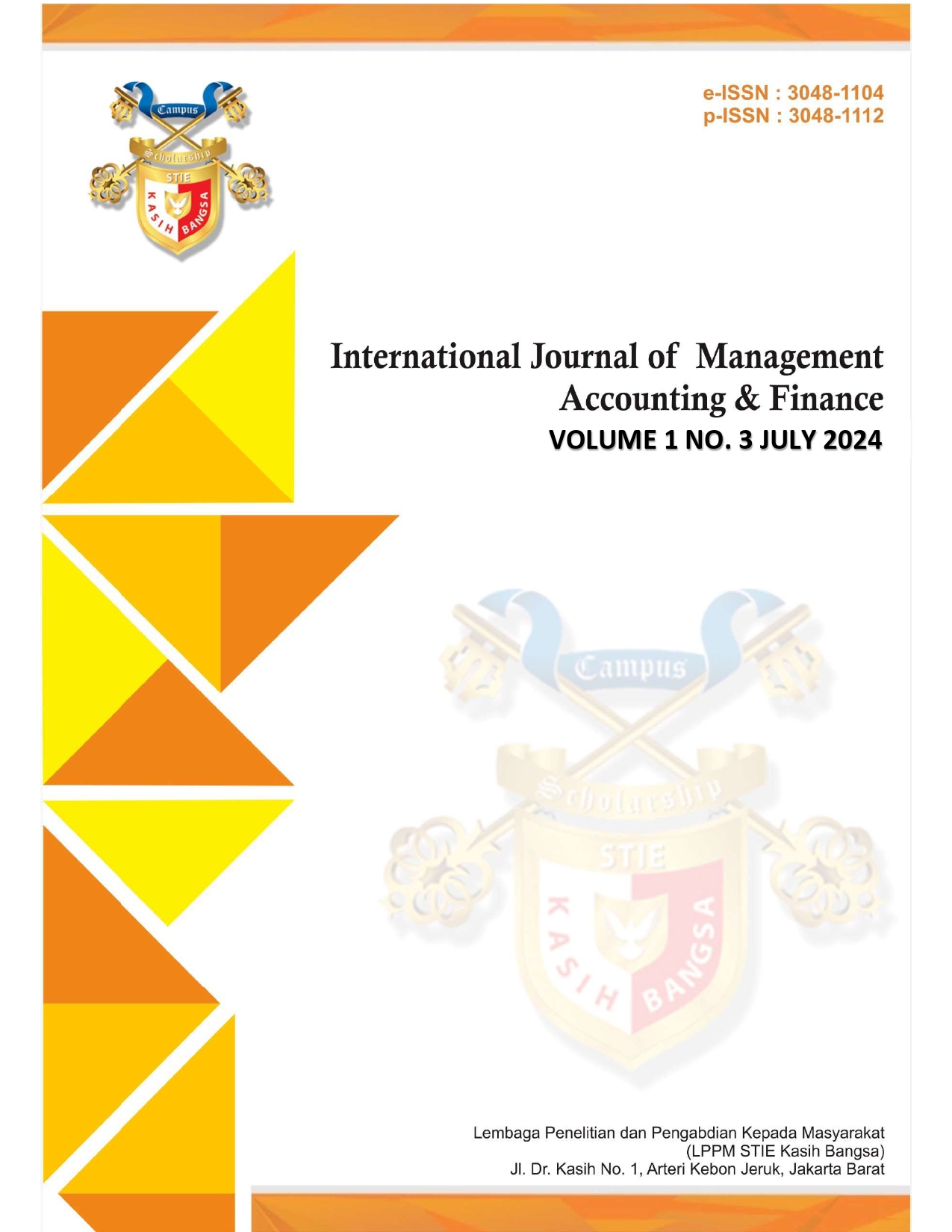Understanding the Dynamics of Risk Sharing and Performance-Based Compensation in Professional Workplaces: Bridging The Theory and The Practice
DOI:
https://doi.org/10.70142/kbijmaf.v1i4.238Keywords:
Risk Sharing, Performance-Based Compensation, Professional Workplaces, Employee Motivation, Organizational DynamicsAbstract
This qualitative literature review investigates the dynamics of risk sharing and performance-based compensation (PBC) in professional workplaces, aiming to bridge the gap between theoretical frameworks and practical applications. By analyzing existing literature, the review reveals that PBC can effectively align employee incentives with organizational goals, enhancing performance and commitment. However, the success of these systems hinges on various factors, including transparent evaluation processes, equitable risk distribution, and the relevance of performance metrics. The findings highlight that while risk-sharing models can drive long-term engagement, they may also expose employees to financial uncertainties, particularly in volatile industries. Moreover, perceptions of fairness and equity in compensation structures play a crucial role in influencing employee motivation and satisfaction. The review emphasizes the necessity for organizations to carefully design PBC systems that consider industry-specific characteristics and employee preferences to mitigate potential adverse effects. Overall, this research contributes to a deeper understanding of the complexities surrounding PBC and risk sharing, paving the way for future studies to explore their implications in diverse contexts.
References
Adams, J. S. (1965). Inequity in social exchange. Advances in Experimental Social Psychology, 2, 267-299.
Aldatmaz, S., Ouimet, P., & Van Wesep, E. D. (2018). The option to quit: The effect of employee stock options on turnover. Journal of Financial Economics, 127(1), 136–151.
Baker, G. (1992). Incentive contracts and performance measurement. Journal of Political Economy, 100(3), 598-614.
Baker, G., Jensen, M. C., & Murphy, K. J. (1988). Compensation and incentives: Practice vs. theory. The Journal of Finance, 43(3), 593-616.
Baron, J. N., & Kreps, D. M. (1999). Consistent human resource practices. California Management Review, 41(3), 29-53.
Bergman, N. K., & Jenter, D. (2007). Employee sentiment and stock option compensation. Journal of Financial Economics, 84(3), 667–712.
Bernhardt, D. (1995). Strategic promotion and compensation. Review of Economic Studies, 62(2), 315–339.
Bloom, M., & Michel, J. G. (2002). The relationships among organizational context, pay dispersion, and managerial turnover. Academy of Management Journal, 45(1), 33-42.
Bloom, N., & Van Reenen, J. (2011). Human resource management and productivity. Handbook of Labor Economics, 4, 1697-1767.
Chen, A. (2024). Firm performance pay as insurance against promotion risk. The Journal of Finance, 79(5), 505–540.
Chen, H. (2003). Tournament theory and incentive contracts: Evidence from the salary distribution of head coaches in the National Football League. Journal of Labor Economics, 21(1), 72-105.
Chen, J. (2003). Moral hazard in promotion tournaments. Review of Economic Studies, 70(3), 515-534.
Clarke, V., & Braun, V. (2014). Thematic analysis. In T. Teo (Ed.), Encyclopedia of Critical Psychology (pp. 1947-1952). Springer.
Colquitt, J. A., Conlon, D. E., Wesson, M. J., Porter, C. O., & Ng, K. Y. (2001). Justice at the millennium: A meta-analytic review of 25 years of organizational justice research. Journal of Applied Psychology, 86(3), 425-445.
Conyon, M. J. (2006). Executive compensation and incentives. Academy of Management Perspectives, 20(1), 25-44.
Creswell, J. W., & Poth, C. N. (2018). Qualitative inquiry and research design: Choosing among five approaches. SAGE Publications.
Devaro, J. (2006). Strategic promotion tournaments and worker performance. Strategic Management Journal, 27(9), 745-764.
Devaro, J., & Gürtler, O. (2015). Optimal incentive contracts with moral hazard and adverse selection: The case of tournaments. Journal of Labor Economics, 33(2), 377-415.
Efing, M., Hau, H., Kampkötter, P., & Rochet, J. C. (2023). Bank bonus pay as a risk sharing contract. Review of Financial Studies, 36(1), 235–280.
Fehr, E., & Schmidt, K. M. (1999). A theory of fairness, competition, and cooperation. Quarterly Journal of Economics, 114(3), 817-868.
Ferreira, D., & Nikolowa, R. (2024). Prestige, promotion, and pay. Journal of Finance, 79(5), 505–540.
Flick, U. (2018). An introduction to qualitative research. SAGE Publications.
Frydman, C., & Jenter, D. (2010). CEO compensation. Annual Review of Financial Economics, 2, 75-102.
Gabaix, X., & Landier, A. (2008). Why has CEO pay increased so much? The Quarterly Journal of Economics, 123(1), 49-100.
Gerhart, B., & Fang, M. (2014). Pay for performance: History, controversies, and future directions. Annual Review of Organizational Psychology and Organizational Behavior, 1(1), 489-513.
Hall, B. J., & Murphy, K. J. (2003). The trouble with stock options. Journal of Economic Perspectives, 17(3), 49-70.
Holmström, B. (1979). Moral hazard and observability. Bell Journal of Economics, 10(1), 74–91.
Jensen, M. C., & Meckling, W. H. (1976). Theory of the firm: Managerial behavior, agency costs, and ownership structure. Journal of Financial Economics, 3(4), 305-360.
Kaplan, R. S., & Norton, D. P. (1996). Using the balanced scorecard as a strategic management system. Harvard Business Review, 74(1), 75-85.
Kruse, D. L., Blasi, J. R., & Freeman, R. B. (2012). Does shared capitalism help the best firms do even better? NBER Working Paper Series.
Kruse, D. L., Blasi, J. R., & Park, R. (2010). Shared capitalism in the U.S. economy: Prevalence, characteristics, and employee views of financial participation in enterprises. In D. L. Kruse, R. B. Freeman, & J. R. Blasi (Eds.), Shared Capitalism at Work: Employee Ownership, Profit and Gain Sharing, and Broad-based Stock Options (pp. 41-81). University of Chicago Press.
Lambert, R. A., & Larcker, D. F. (1987). An analysis of the use of accounting and market measures of performance in executive compensation contracts. Journal of Accounting Research, 25, 85-129.
Lambert, R. A., Larcker, D. F., & Weigelt, K. (2018). The structure of organizational incentives. Administrative Science Quarterly, 33(1), 52-73.
Lazear, E. P., & Rosen, S. (1981). Rank-order tournaments as optimum labor contracts. Journal of Political Economy, 89(5), 841–864.
Lincoln, Y. S., & Guba, E. G. (1985). Naturalistic inquiry. SAGE Publications.
Miles, M. B., Huberman, A. M., & Saldaña, J. (2014). Qualitative data analysis: A methods sourcebook. SAGE Publications.
Moher, D., Liberati, A., Tetzlaff, J., & Altman, D. G. (2009). Preferred reporting items for systematic reviews and meta-analyses: The PRISMA statement. PLoS Medicine, 6(7), e1000097.
Murphy, K. J. (2013). Executive compensation: Where we are, and how we got there. Handbook of the Economics of Finance, 2, 211-356.
Nowell, L. S., Norris, J. M., White, D. E., & Moules, N. J. (2017). Thematic analysis: Striving to meet the trustworthiness criteria. International Journal of Qualitative Methods, 16(1), 1-13.
Oyer, P., & Schaefer, S. (2005). Why do some firms give stock options to all employees? An empirical examination of alternative theories. Journal of Financial Economics, 76(1), 99–133.
Patton, M. Q. (2015). Qualitative research & evaluation methods: Integrating theory and practice. SAGE Publications.
Saldana, J. (2015). The coding manual for qualitative researchers. SAGE Publications.
Silverman, D. (2020). Qualitative research. SAGE Publications.
Sliwka, D., & Werner, S. (2013). Incentives for managers and inequality among workers: Evidence from a natural experiment. Journal of Labor Economics, 31(3), 513-533.
Snyder, H. (2019). Literature review as a research methodology: An overview and guidelines. Journal of Business Research, 104, 333–339.
Thomas, J., & Harden, A. (2008). Methods for the thematic synthesis of qualitative research in systematic reviews. BMC Medical Research Methodology, 8, 45.
Torraco, R. J. (2005). Writing integrative literature reviews: Guidelines and examples. Human Resource Development Review, 4(3), 356–367.
Tranfield, D., Denyer, D., & Smart, P. (2003). Towards a methodology for developing evidence‐informed management knowledge by means of systematic review. British Journal of Management, 14(3), 207-222.
Vandenberghe, C., & Tremblay, M. (2012). Compensation, motivation, and performance in a dual career context. International Journal of Human Resource Management, 23(6), 1215-1234.
Wang, X. H., & Yin, Y. (2023). Incentive contracts and turnover: Evidence from the National Football League. Journal of Sports Economics, 24(2), 103–121.
Yamamoto, H. (2024). Employee stock options and organizational performance: The role of financial and human capital. The Journal of Finance, 79(5), 505–540.
Yuan, J., & Zhang, Y. (2016). The effect of pay-for-performance on employee turnover: Evidence from the hotel industry. International Journal of Hospitality Management, 53, 54-63.
















